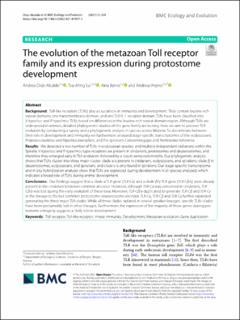| dc.description.abstract | Background: Toll-like receptors (TLRs) play a crucial role in immunity and development. They contain leucine-rich repeat domains, one transmembrane domain, and one Toll/IL-1 receptor domain. TLRs have been classified into V-type/scc and P-type/mcc TLRs, based on differences in the leucine-rich repeat domain region. Although TLRs are widespread in animals, detailed phylogenetic studies of this gene family are lacking. Here we aim to uncover TLR evolution by conducting a survey and a phylogenetic analysis in species across Bilateria. To discriminate between their role in development and immunity we furthermore analyzed stage-specific transcriptomes of the ecdysozoans Priapulus caudatus and Hypsibius exemplaris, and the spiralians Crassostrea gigas and Terebratalia transversa.
Results: We detected a low number of TLRs in ecdysozoan species, and multiple independent radiations within the Spiralia. V-type/scc and P-type/mcc type-receptors are present in cnidarians, protostomes and deuterostomes, and therefore they emerged early in TLR evolution, followed by a loss in xenacoelomorphs. Our phylogenetic analysis shows that TLRs cluster into three major clades: clade α is present in cnidarians, ecdysozoans, and spiralians; clade β in deuterostomes, ecdysozoans, and spiralians; and clade γ is only found in spiralians. Our stage-specific transcriptome and in situ hybridization analyses show that TLRs are expressed during development in all species analyzed, which indicates a broad role of TLRs during animal development.
Conclusions: Our findings suggest that a clade α TLR gene (TLR-Ca) and a clade β/γ TLR gene (TLR-Cβ/γ) were already present in the cnidarian-bilaterian common ancestor. However, although TLR-Ca was conserved in cnidarians, TLR-Cβ/γ was lost during the early evolution of these taxa. Moreover, TLR-Cβ/γ duplicated to generate TLR-Cβ and TLR-Cγ in the lineage to the last common protostome-deuterostome ancestor. TLR-Ca, TLR-Cβ and TLR-Cγ further expanded generating the three major TLR clades. While all three clades radiated in several spiralian lineages, specific TLRs clades have been presumably lost in other lineages. Furthermore, the expression of the majority of these genes during protostome ontogeny suggests a likely role in development. | en_US |

